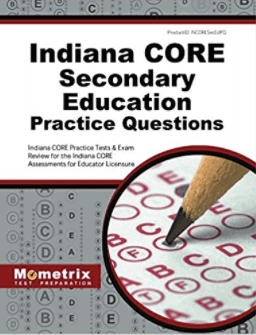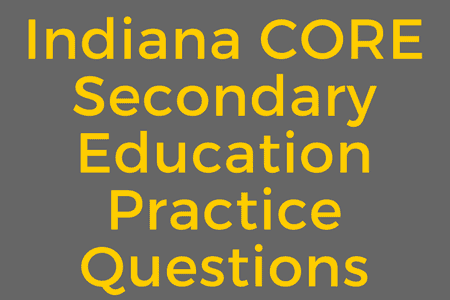Becoming a teacher in the state of Indiana means that you will need to take and pass the Indiana CORE Assessment for Educator Licensure. Under the Indiana CORE Assessment for Educator Licensure, there are several exams that you can take depending on which specialty you are wanting to go into, such as Career and Technical Education and Elementary Education.
The Indiana CORE Assessment helps the Department of Education to meet their goals of ensuring that candidates have the developmental and content area knowledge and skills that will be needed to effectively teach in Indiana public schools.
The Indiana CORE Assessment is aligned with state and national standards for educator preparation and also with state standards for the P-12 curriculum in Indiana.
The Indiana CORE Secondary Education exam is one of the many exams that you can take to become a teacher in Indiana. The Indiana CORE Secondary Education exam is a computer-based test that includes 100 multiple-choice questions. The exam is timed for 105 minutes. The passing score for the Indiana CORE Secondary Education exam is 220.

The Indiana CORE Secondary Education exam consists of five domain areas:
- Student Development and Diversity
- Learning Processes and Environments
- Instruction and Assessment
- Reading Instruction
- The Professional Environment
Indiana CORE Secondary Education Practice Questions
- When sixth-graders fail to complete assignments or act out in class, to which of the following are teachers with experience and developmental perspectives more likely to attribute such events accurately, whereas teachers without these assets are more likely to choose one of the others?
a. ADHD
b. Mental illnesses
c. Behavioral problems
d. Adjustment problems
2. According to experts, what is true about an effective instructional strategy that helps teaching and student learning and performance?
a. Teachers’ telling students success stories will not help them see cause and effect.
b. Teachers should have students keep logs to help them connect efforts to results.
c. Teachers’ tangible rewards to students are more effective than symbolic rewards.
d. Teachers should ensure equitable treatment by making student rewards uniform.
3. Which of these most describes developmental activities of later adolescence?
a. Establishing realistic goals for life and pursuing them
b. Applying cognitive skills and developing self-images
c. Separating from parents, exploring, experimenting
d. Developing responsibility, self-reliance, and control
Answers
- D: Although Attention Deficit Hyperactivity Disorder or ADHD (a) certainly includes inattention, short attention span, and impulsive behavior; students with mental illnesses (b) certainly can have difficulty completing assignments and/or exhibit disruptive class behavior; and assignment noncompliance and acting out in class can certainly be symptoms of behavior problems (c), teachers with more experience and developmental perspectives are more likely than those without these assets to realize such behaviors can actually be signs of adjustment problems. Many students begin middle school in sixth grade. Because schools can vary widely and because of change itself, students can have difficulty making transitions to middle school. The same applies to transitions from middle to high school.
- B: As educator expert Robert Marzano has noted, effective instructional strategies include relating success stories to students, which reinforces their efforts in school and helps them see the causal relationship between effort and achievement. Another strategy that promotes this connection is having students keep logs and analyze them (b). Marzano advises teachers to give symbolic, not tangible, rewards to students (c) to recognize their efforts and achievements more effectively and to personalize or individualize those rewards for each student to make them more meaningful and relevant than uniform rewards (d).
- A: In early adolescence, teens engage in developmental activities including applying their emergent cognitive skills and developing new self-images (b) based on their physiological changes. In middle adolescence, developmental tasks include separating from parents, exploring relationships, and experimenting with different ideas and behaviors (c), and developing responsibility, self-reliance, and greater control (d) of their learning and work opportunities and activities, as well as finding their place in society and contributing to it. In later adolescence, developmental activities include stabilizing their personal identities and social roles; integrating their worldviews and psychologies and making these more consistent; balancing fantasy, aspiration, and reality; shifting from self-interest to caring for and giving to others, and establishing realistic life goals and pursuing them (a).

